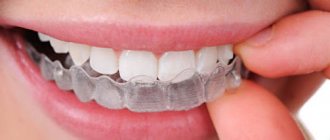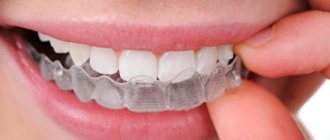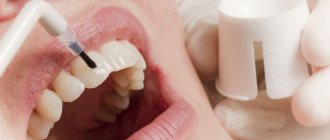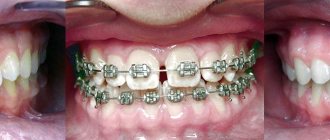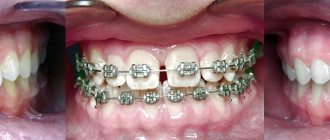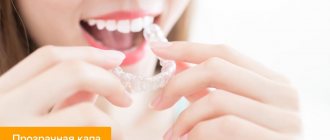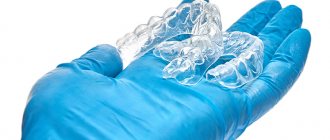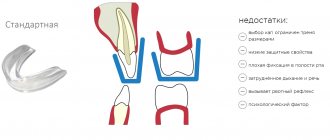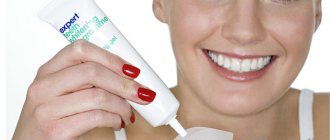Enamel is the hardest tissue in the body. Its density is determined by the minerals it contains. When their quantity decreases, the enamel loses its properties, quickly collapses, and the patient complains of sensitivity to hot and cold. Remineralizing therapy in dentistry allows you to restore hard tissues and prevent the development of caries.
| Prices for remineralizing therapy | |
| Remineralizing therapy (for 2 jaws) | 3200 R |
What is a dental guard?
In modern dentistry, there are many types of mouth guards, differing in their purpose.
With its help, it can protect teeth, promote their alignment, whiten and strengthen tooth enamel. A mouthguard is a removable device, i.e. a dental cover made of transparent material that covers the entire dentition. A dental mouth guard can be used to protect teeth during times of increased stress, such as during sports, to whiten teeth, straighten teeth, and reduce stress on the jaw.
The principle of operation of the cap is mechanical pressure on areas requiring correction. Each tooth is located in a specific socket and is surrounded by connective tissue that holds it in place. If constant pressure is applied to it, over time the tooth will change position.
Enamel composition, imbalances
The main chemical elements that form tooth enamel are calcium and phosphorus. Poor nutrition, changes in pH in the oral cavity, active proliferation of bacteria, and changes in the composition of saliva lead to a decrease in the concentration of microelements. This leads to tooth decay and the need for dental treatment.
Factors provoking demineralization:
- diseases of the digestive system;
- lack of microelements in the diet;
- accumulation of food debris, plaque formation;
- inflammation of soft tissues;
- poor dental care;
- smoking, excessive consumption of tea, coffee;
- destruction of enamel under the influence of mechanical factors;
- decreased immunity;
- hormonal disorders;
- simultaneous consumption of cold and hot foods and drinks;
- elderly age;
- lack of calcium and phosphorus during pregnancy, active skeletal growth in a child.
Types of mouth guards
Silicone mouth guards for athletes
Sports or protective mouthguards are designed for those who play contact sports such as hockey, football, boxing or prefer extreme recreation. These mouthguards on the front teeth help reduce the mechanical impact on the jaw and prevent damage not only to the teeth and soft tissues of the face, but also to the cervical spine.
There are two types of protective sports mouth guards:
- standard mouth guard - made according to a single sample and completely ready for use;
- custom mouth guards - made from biopolymers based on personal impressions, which allows you to reproduce all the structural characteristics of the dentition.
Orthodontic aligners
These are structures for aligning the dentition, made according to individual impressions of the patient’s jaws. Unfortunately, not all of these bite-correcting mouthguards are able to cope with serious malocclusions. They are mainly effective in eliminating interdental spaces and correcting some malocclusion pathologies. However, when it comes to Invisalign® orthodontic aligners, they can easily be considered as an alternative to braces.
Mouth guards for teething
There is another type of dental aligner: trainers. They are also called teething guards, teething guides or LM activators. Various models of this type of mouthguard are made of silicone. They are available in different sizes. Despite the name, teething protectors are actually used to correct the jaw relationship and align the incisors in children between the ages of 6 and 10 years, which is the early stage of malocclusion. How long to wear the aligners? The child needs to wear the mouthguards for several hours, day and night. The treatment period is usually about one year with periodic monitoring of intermediate results based on impressions of the jaws taken at various stages of correction.
Teeth whitening trays
If you want to achieve a genuine smile, but for some reason in-office whitening procedures are not an option for you, you can make your teeth whiter at home with professional systems using a custom, standard or disposable thermoplastic dental tray whitening gel. However, if this is the case, you will still need to visit your dentist to take an impression and make your own mouth guard or simply learn how to use a mouth guard. At the same time, be prepared for the fact that the whitening process using this technology will be slow and will take at least a month, since the percentage of hydrogen peroxide in the gel is lower than in office whitening systems. But this method is considered most suitable for teeth with increased sensitivity.
How to wear a teeth whitening tray at home? First you need to brush your teeth, apply the gel inside the tray and put it on, pressing lightly so that the gel is evenly distributed. Next, you need to rinse your mouth and put on the mouth guard for the time specified in the instructions. Then remove the mouthguard and rinse your mouth with water again.
Dental mouthguards
Dental mouth guards are also used for remineralization procedures. A special gel or paste is applied to the inner surface of the mouthguard and pressed tightly against the teeth. Regular use of a device filled with a mineralizing composition can effectively strengthen and restore tooth enamel. These mouthguards come in standard and thermoplastic varieties. A thermoplastic dental tray is made of a flexible material that softens when immersed in hot water. After this, it is immediately applied to the teeth and the material hardens.
Remineralizing therapy using Tooth Mousse and MI Paste Plus (GC)
The problem of such a common disease as dental caries occupies one of the leading places in therapeutic dentistry [8]. Today, the arsenal of remineralizing therapy products is diverse both in composition and in methods of application. To introduce active components into tooth tissue, the following are used: applications, rinses, gels, varnishes, pastes, films, electrophoresis and phonophoresis, etc.
The chemical composition and direction of the preventive effects of these agents are determined by the processes occurring in the area of carious lesions. The main goal of the pathogenetic effect is to restore the composition and structure of the main mineral component of the enamel. This is achieved in several ways: by creating conditions for the recrystallization of hydroxyapatite or by growing its analogs with lower solubility [5–7].
Fluorapatite has greater dynamic stability than hydroxyapatite, which determines its greater resistance. The formation of fluorapatite from hydroxyapatite occurs at a certain ratio of calcium and phosphorus in the mineralizing solution and at low fluorine concentrations [1, 3, 10, 12]. Selecting the optimal ratio of active components in mineralizing solutions is a very difficult task. You can alleviate it by using natural mineralized products. Thus, the well-known bone tissue hydrolyzer “Remodent” [11] was proposed as a remineralizing agent, which has proven itself to be an excellent remineralizing drug.
With that said, our focus has been on selecting natural mineralizing products. Of the variety of modern products, we were interested in the bioavailable remineralizing preparations Tooth Mousse and MI Paste Plus (GC Corporation, Japan).
Tooth Mousse
Tooth Mousse (GC Corporation, Japan) - “Mousse for teeth”, or “Liquid enamel”. The active component of “liquid enamel” is Recaldent®, containing the CPP-ACP complex (casein phosphopeptide - amorphous calcium phosphate). CPP-ACP was developed by the School of Dental Science, University of Melbourne Victoria/Australia (Recaldent® used under license from Recaldent® Pty. Limited).
The CPP-ACP complex is produced from casein in milk. Milk casein is a carrier of active ingredients and binds freely to enamel, biofilm, plaque and soft tissue, delivering calcium and phosphate where they are most needed. Amorphous calcium phosphate complex is a perfectly balanced combination that is identical to the lost components of tooth enamel and provides tooth enamel with free calcium and phosphate ions.
Mousse for teeth is an application preparation for restoring mineral balance in the oral cavity and remineralization. It is used to reduce the sensitivity of dental tissues after whitening, professional cleaning, curettage, orthodontic treatment, prevention of caries in the early stages and to normalize salivation.
MI Paste Plus
MI Paste Plus (GC Corporation, Japan) is a water-based cream containing Recaldent® with the addition of CPP-ACPF fluoride: casein phosphopeptide - amorphous calcium phosphate fluoride. The fluoride level is 0.2% (900ppm), which is approximately the same as the concentration found in adult toothpastes. In the oral cavity, CPP-ACPF molecules bind to biofilm, dental plaque, hydroxyapatite crystals of dental enamel and settle on soft tissues, localizing bioavailable calcium, phosphate and fluoride.
PURPOSE OF THE STUDY
To study the remineralizing effectiveness of Tooth Mousse and MI Paste Plus cream.
MATERIALS AND METHODS
The effect of the drugs was studied by assessing the effectiveness of remineralizing therapy performed on patients of the dental department of the Rostov State Medical University clinic. A total of 16 patients, students of Rostov State Medical University, who applied for oral sanitation, participated in the clinical observation.
The average age of the patients was 23±2.0 years. All applicants required sanitation of the oral cavity; 5 people complained of enamel hyperesthesia; in 11 of those observed, foci of initial dental caries were identified. The scope of clinical dental examinations and treatments included: a survey, an external examination, an assessment of oral hygiene and hard dental tissues. The assessment of the condition of the teeth included the indexes of dental caries intensity (DCI) and CSI of cavities (CPUp). Initial caries was determined by counting and staining demineralized spots.
The oral cavity examination began with identifying complaints and collecting anamnesis. Oral hygiene was assessed using the Yu. A. Fedorov - V. V. Volodkina index.
The processes of remineralization of tooth enamel were assessed using the enamel resistance test (ERT) and the mineralizing potential of saliva (MP).
The scope of clinical dental examinations and treatments included: a survey, an external examination, an assessment of oral hygiene and hard dental tissues. The assessment of the condition of the teeth included the indices KPUz and KPUp TER test (V.R. Okushko and L.I. Kosareva) evaluates the resistance of tooth enamel to the action of acids [10, 12]. Methodology: the central incisor of the upper jaw was cleaned of soft plaque with a solution of hydrogen peroxide, dried with a cotton swab and isolated from saliva. To the middle of the vestibular surface of the tooth for 5 seconds. etchant acid with a diameter of 2-3 mm was applied. The etched area was then stained with a 1% aqueous solution of methylene blue. Using abrasive movements, the dye was removed with a dry cotton swab, carefully pressing it to the surface of the tooth. The dye is completely removed from the unetched enamel surface, leaving the etched area colored.
To assess the intensity of coloring, a 10-field typographic blue scale was used from 10 to 100% color intensity. With a staining intensity of 30%, tooth enamel is resistant to acidic factors; with staining from 30 to 60%, tooth enamel is moderately resistant to acids; with an intensity of 60 to 100%, tooth enamel is unstable to acids.
The mineralizing potential of saliva (P. A. Leus) gives an idea of the saturation of oral fluid with microelements [4, 12]. Method: 3 drops of saliva were applied to a glass slide using a pipette and dried at a temperature of 37 C. The preparations were examined under a microscope at low magnification.
The type of microcrystallization of oral fluid was determined. The first type of microcrystallization corresponded to saliva saturated with microelements and represented elongated, prismatic crystal structures, often with a radial orientation. The second type corresponded to the average level of saliva saturation with calcium and other elements and looked like isometrically located fragments of crystals, without a clear orientation. The third type corresponded to saliva poor in microelements - scattered small single unoriented fragments of crystals.
The severity of demineralization processes was studied by the degree of activity of foci of initial dental caries (L. A. Aksamit). The intensity of foci of demineralization—white carious spots—was assessed using the vital staining method [2]. The teeth to be examined were carefully isolated from saliva, and a cotton swab generously moistened with a 2% solution of methylene blue was applied to the carious stain.
After using Tooth Mousse and MI Paste Plus, the enamel became more resistant to acids and more resistant to cariogenic factors. After 3 minutes, the tampon was removed, the excess dye was washed off with water. To assess the intensity of staining, a standard color scale was used, providing various shades of blue from slightly bluish to dark blue. The results obtained were assessed in points (from 1 to 10 points). When the intensity of staining of the foci is up to 3 points, the activity of demineralization is low, from 3 to 6 points - the activity is of medium degree, from 6 to 10 points - the activity of demineralization foci is high.
During clinical observation, all patients underwent professional oral hygiene and personal hygiene correction. After sanitation of the oral cavity, the studied remineralization agents were prescribed. The observed patients used “liquid enamel” in addition to their usual toothpastes. Tooth Mousse and MI Paste Plus cream were applied to the teeth after brushing every day, before bed, for a month. The effectiveness of remineralizing therapy was assessed immediately after monthly therapy and over time after 6 months. Of the observed patients, 11 people used Tooth Mousse and 5 people used MI Paste Plus cream.
Research results
Below are the results of using the remineralizing therapy drugs Tooth Mousse and MI Plus (GC Corporation, Japan).
An assessment of the condition of the teeth using the indices of the CPU of teeth and CPU of cavities showed that the values of these indices are quite high and remineralization therapy is indicated for all observed patients. Thus, the CPU index of teeth had a value of 9.1 ± 0.8, and the CPU index of cavities was 10.7 ± 1.0. Initial dental caries was registered in 68.8% of patients who applied for oral cavity sanitation. The average number of initial caries was 1.6 ± 03, i.e., on average, 1-2 foci of initial caries were recorded in each patient, and the intensity of demineralization of the identified foci corresponded to 5.3 ± 0.9 points, which indicates the active course of the initial dental caries.
During the period of use of Tooth Mousse and MI Paste Plus cream, all indicators of the processes of de- and remineralization in the oral cavity changed. Analysis of the state of oral hygiene of the examined patients showed that as a result of the correction of hygienic skills and therapeutic and preventive measures, the level of hygiene improved and the indicators of hygiene indices ( GI) decreased during the observation period. So, if initially the GI had a value of 1.8 - 0.3 points, which corresponds to a satisfactory level of hygiene, after a month the GI was rated as “good” and had a value of 1.4 - 0.1 points.
The effectiveness of remineralizing therapy of the studied drugs was assessed immediately after a monthly course of applications. During the period of using Tooth Mousse and MI Paste Plus cream, all indicators of de- and remineralization processes in the oral cavity changed. These indicators in the groups of patients using only Tooth Mousse or only MI Paste Plus had comparable changes, so the evaluation of the effectiveness of the drugs was carried out in the general group of patients and was not divided by the drugs used (Table No. 1).
Table No. 1. Indicators of de- and remineralization processes in the oral cavity during the use of Tooth Mousse and MI Paste Plus cream (M±m).
Observation | Vital staining of foci of initial dental caries (points) | Enamel resistance test of the surface layer of tooth enamel (%) | Microcrystallization of a dried drop of oral fluid (type) |
| Before remineralizing therapy | 5,3 ±0,9 | 50,0 ±3,4 | III type |
| After remineralizing therapy | 1,4 ±0,4 | 36,9±1,9 | Type I |
| R | < 0,05 | < 0,05 | < 0,05 |
Thus, the activity indicators of initial caries in all observed patients decreased. The intensity of demineralization foci decreased by 3.8 times. Thus, before retherapy, the activity of carious lesions corresponded to a value of 5.3 ± 0.9 points, after therapy - 1.4 ± 0.4 points, with (p < 0.05).
Remineralization processes in the oral cavity have significantly improved. Analysis of indicators characterizing the resistance of tooth enamel to acids demonstrates that after using Tooth Mousse and MI Paste Plus, the condition of the surface layer of enamel became more resistant to acids, and the enamel became more resistant to cariogenic factors. Thus, according to the resistance test (TER), the indicators decreased from 50.0 ± 3.4% to 36.9 ± 1.9%.
Characteristics of the remineralizing properties of saliva showed that the oral fluid became more saturated with microelements (Table No. 1). The average indicators for saliva microcrystallization before treatment corresponded to type III - unformed crystals (2.8 - 0.1 points), after treatment - to type I - formed crystal lattice (1.3 - 0.2 points).
Dynamic monitoring of the effectiveness of remineralizing therapy showed that there was a significant preservation of indicators based on data characterizing the process of demineralization of tooth enamel and the mineralizing potential of saliva (Table No. 2).
Table No. 2. Indicators of dynamic monitoring of the effectiveness of remineralizing therapy when using Tooth Mousse and MI Paste Plus cream (M±m).
Observation | Vital staining of foci of initial dental caries (points) | Enamel resistance test of the surface layer of tooth enamel (%) | Microcrystallization of a dried drop of oral fluid (type) |
| Before remineralizing therapy | 5,3 ±0,9 | 50,0 ±3,4 | III type |
| 6 months after remineralizing therapy | 2,5 ±0,5 | 45,5±0,9 | Type II |
| R | < 0,05 | > 0,05 | < 0,05 |
Thus, after 6 months, the average activity indicators of initial caries foci were 2.5-0.5 points versus 5.3-0.9 points before treatment (p < 0.05).
Indicators of the mineralizing potential of saliva after 6 months corresponded, on average, to type II microcrystallization (1.8–0.2 points) compared to the initial type III microcrystallization (2.8–0.1 points), with (p < 0.05). In terms of indicators characterizing the processes of enamel resistance to acids, we did not identify any pronounced differences compared to the initial values. Thus, the acid resistance of enamel (AER) after 6 months corresponded to 45.5-0.9% and became comparable to the initial 50-3.4% (p > 0.05).
Also, an analysis of indicators over time demonstrated that MI Paste Plus cream (containing fluoride compounds) has more stable results for all studied indicators (Table No. 3, 4).
Table No. 3. Indicators of dynamic monitoring of the effectiveness of remineralizing therapy when using MI Paste Plus cream (M±m).
Observation | Vital staining of foci of initial dental caries (points) | Enamel resistance test of the surface layer of tooth enamel (%) | Microcrystallization of a dried drop of oral fluid (type) |
| Before remineralizing therapy | 5,3 ±0,9 | 50,0 ±3,4 | III type |
| 6 months after remineralizing therapy | 2,4 ±0,5 | 40,5±0,9 | Type I |
| R | < 0,05 | < 0,05 | < 0,05 |
Table No. 4. Indicators of dynamic monitoring of the effectiveness of remineralizing therapy when using Tooth Mousse (M±m).
Observation | Vital staining of foci of initial dental caries (points) | Enamel resistance test of the surface layer of tooth enamel (%) | Microcrystallization of a dried drop of oral fluid (type) |
| Before remineralizing therapy | 5,3 ±0,9 | 50,0 ±3,4 | III type |
| 6 months after remineralizing therapy | 2,5 ±0,5 | 45,5±0,9 | Type II |
| R | < 0,05 | > 0,05 | < 0,05 |
Analysis of the data on the demineralization process showed that after 6 months in the group of patients who used MI Plus cream, stable stabilization of the demineralization process of tooth enamel remained (2.4-0.5 points versus 5.3-0.9 points before treatment).
According to the enamel acid resistance test (ERT), the 6-month follow-up indicators in this group had comparable differences with the data before treatment (40.0 - 2.8% and 50.0 ± 3.4%). Indicators of mineral saturation of oral fluid in the group using MI Plus cream after 6 months continued to correspond to the high mineralizing potential of saliva (1.2-0.2 points with 2.8-1.2 points before treatment).
Thus, the remineralizing products Tooth Mousse and MI Paste Plus:
- have a regulatory effect on the processes of de- and remineralization in the oral cavity;
- stabilize demineralization processes (the activity of initial caries is suspended);
- normalize the saturation of oral fluid with microelements;
- increase the resistance of the surface layer of tooth enamel to cariogenic factors.
The most effective in our observation was a product containing fluoride compounds: MI Paste Plus cream.
CONCLUSION
Remineralizing preparations Tooth Mousse and MI Paste Plus (GC Corporation, Japan) are effective means for regulating the processes of de- and remineralization of hard dental tissues.
LITERATURE
- Avramov O. G. Processes of remineralization and permeability of tooth enamel during oral hygiene / O. G. Avramov // Proceedings of the Fifth Congress of the Russian Dental Association. - M., 1999. - P. 39.
- Aksamit L. A. Diagnosis of the initial stage of enamel demineralization using the staining method. - M. 1973. - P. 4-5.
- Borovsky E. V. Biology of the oral cavity / V. E. Borovsky, V. K. Leontiev. - M.: Medicine, 2001. - 304 p.
- Denisov A. B. Diagnostic informativeness of saliva. Research prospects / A. B. Denisov // Dental Review. Education, science and practice in dentistry: Abstracts of reports of the All-Russian Dental Forum. - M., 2004. - P. 253-256.
- Knappvost A. The influence of fluoride ions on the physiological and pathological metabolism of calcium: caries, osteoporosis, atherosclerosis (Hamburg) / A. Knappvost // Maestro. - 2000, No. 1. - P. 57-60.
- Kolesnik A.G. Chemical means for the prevention of dental caries / A.G. Kolesnik, T.L. Pilat // Dentistry. - 1989, No. 1. - P. 86-89.
- Kolpakov V.V. Physiological bases of prevention of dental diseases / V.V. Kolpakov, A.V. Bragin, A.L. Ivanova, A.V. Starikova // Materials of the IX and XI All-Russian Scientific and Practical Conferences and Proceedings of the VIII Congress of Dental Medicine Association of Russia. - M., 2003. - P. 313-315.
A complete list of references is in the editorial office.
Indications and contraindications for the use of mouth guards
Effective results are achieved with mouth guards only if they are used according to the wearing instructions. There are the following indications for which aligners should be used as part of orthodontic treatment:
- too large spaces between teeth (gaps);
- crowding, curling of teeth;
- enlarged or narrowed dental arch;
- as the final stage of using braces (instead of retainers).
- whitening effect.
Mouthguards correct slight crooked teeth, while they are completely invisible when worn, they can also be temporarily removed and then fixed again. If the patient is forced to hold an important event, a business meeting, such mobility of this product can greatly facilitate negotiations. The patient can remove this medical device for a couple of hours and then put it back on.
An interesting method of whitening with caps was developed by doctors who began to use this product together with special whitening pastes saturated with fluoride and potassium, which help reduce tooth sensitivity. In addition, the composition of the whitening paste itself may vary depending on the degree of yellowing of the teeth. This procedure is not a panacea for all patients. This method requires medical supervision. It has a number of contraindications. It means:
- allergic reactions to the components of the whitening paste;
- age less than 18 years;
- gum disease and some dental problems;
- wearing earrings in the lip area (piercing).
Mouth guards can only be used for minor defects in the dental system that lead to disruption of the aesthetics of the smile. An orthodontist will not prescribe the use of caps for severe bite deviations, since in this case the treatment will not be able to bring a positive result.
Mouth guards for bruxism
Bruxism is nighttime teeth grinding, in which, due to involuntary contraction of the masticatory muscles, an excessive load on the dental system occurs, which leads to various pathologies.
Consequences of bruxism:
- Abrasion of tooth enamel, increased sensitivity of teeth;
- Chips and cracks in enamel;
- Wedge-shaped defects;
- Fracture of the dental crown;
- Periodontitis;
- Inflammation of the gums;
- Damage to fillings, prosthetic structures;
- Pain in the maxillofacial joints;
- Headache;
- Loose teeth.
Bruxism is treated by therapists, psychologists, and neurologists; the disease is treated in a dental clinic by an orthopedist and an orthodontist; if necessary, a periodontist is involved. One way to combat nighttime teeth grinding is a protective mouth guard, which is worn only while sleeping.
Mouth guards for bruxism are made according to individual impressions; most often they are made for one jaw, but it is also possible to make a two-jaw unloading mouth guard. The mouthguard reduces the load on the maxillofacial joints, thanks to it the teeth do not close together, so there is no close contact between them. With regular use of the device, the number of bruxism attacks per night is reduced, teeth and orthopedic structures are preserved from damage. Mouthguards are made of lightweight elastic material, so they do not interfere with falling asleep and staying asleep.
In case of bruxomania - daytime teeth grinding - the patient is recommended to wear daytime mouthguards (if he is not able to independently control the force of jaw clenching). The devices have a special structure, so they are not visible during conversation and do not interfere with eating.
It should be borne in mind that a mouthguard for bruxism should be used in conjunction with therapeutic therapy; psychologists, neurologists, and possibly other specialists also participate in the treatment.
Do mouthguards help straighten teeth?
In search of a means to correct dentition, many people wonder whether straightening teeth with mouth guards will bring the expected effect. Their fears are related precisely to the wrong choice of caps, which does not lead to the expected result. Remember: only specially designed mouth guards made according to your impression right in the clinic are suitable for correcting your bite and straightening your teeth. Sports masks, whitening or remineralizing masks are not intended for this! In addition, there are a number of rules that must be followed when wearing a mouthguard, otherwise you will not benefit from all their benefits.
Features of wearing mouth guards to correct teeth bite
Aligners are made after a comprehensive examination of the oral cavity and determination of the nature of the defect. Based on the cast, a plaster model is created, which serves as a guide for making the trays. Several pairs may be needed during the entire course of treatment. This is because the aligners need to be replaced every 2-3 weeks to gradually move the teeth and correct the bite.
It is advisable to wear the structures for at least 20–22 hours a day. They are allowed to be removed while eating, so you don’t have to give up your usual foods.
Aligner care includes:
- brushing the outside with a soft brush and toothpaste twice a day;
- rinsing with clean water after each meal;
- storage after removal in protective containers with ventilation holes;
- protection from mechanical or chemical influences (cannot be immersed in hot water).
You can find out all the nuances of bite correction using mouthguards from the orthodontists of the Vimontale aesthetic dentistry clinic.
Expert of the article you are reading:
Bystrov Alexey Albertovich
Dentist orthodontist, general dentist
You may also be interested in:
Aligners Ceramic braces Lingual braces Combined braces Trainers for teeth straightening Treatment with braces Braces for children
Show more
How to wear a dental mouthguard correctly
Depending on the structure of the jaw and the recommendations of the orthodontist, a dental guard can be worn:
- Constantly (20-22 hours a day, taking off just to eat and brush your teeth). This method is chosen if it is necessary to correct the bite, eliminate diastemas, or correct the position of the teeth relative to each other. It is completely safe, even aesthetically pleasing: many celebrities constantly wear transparent aligners - they are practically invisible.
- Only for the night. This applies to dental night guards, which are prescribed to maintain the effect achieved by the appliance when the bite has already been aligned and only need to be maintained.
The mouthguards are very easy to use: they are easy to put on and easy to remove without assistance. To care for them, just clean them with a regular toothbrush and rinse well with water. In addition, mouthguards should not be used to chew gum or eat other foods that stick to the teeth (taffy, butterscotch).
To check the evenness of your bite, you need to visit your dentist every 2-3 months. The doctor will determine how long to wear the mouth guard - typically, the duration of wearing the mouth guard is 3 years or more.
Protective/Sports Mouthguards
Such devices are used when playing sports of various levels of contact (martial arts, hockey, rugby and other traumatic sports).
The purpose of such mouthguards is to prevent traumatic damage to teeth, jaws and soft tissues.
There are also devices (mouthguards) that, when put on the teeth, limit the closure of the jaws, which can be advisable in the treatment of disorders of the temporomandibular joint (TMJ), involuntary grinding of teeth (bruxism), snoring, apnea (involuntary stops of breathing during sleep ) and other violations.
Advantages and disadvantages of caps
Wearing this orthodontic design provides the patient with a number of advantages:
- made of transparent material and invisible to others;
- These are removable devices that allow for complete oral hygiene and food intake;
- in the manufacture of caps, hypoallergenic and safe materials for enamel and mucous membranes are used;
- do not cause speech impairment;
- period of rapid adaptation;
- copes well with bite problems in children and is actively used in pediatric orthodontics;
- easy to care for during daily hygiene procedures, does not require special detergents or special cleaning methods;
- works well in complex therapy in the treatment of teeth grinding and bruxism.
The disadvantages include:
- does not correct serious malocclusions;
- the time of using the mouth guard is controlled by the patient himself, so the result largely depends on his conscientiousness;
- The aligner does not correct serious defects - crowded teeth, severe curvature;
- the high cost of some types of hats.
Indications
Remineralization for preventive purposes is often carried out in childhood, starting from 6 years. This therapeutic procedure serves as a prevention of caries, which often affects fragile teeth. For adults, the procedure is recommended after removing hard deposits, removing orthodontic structures, and whitening. It is also carried out during pregnancy, lactation, and for dental anomalies.
For medicinal purposes, remineralization is indicated for caries in the stain stage, increased tooth sensitivity, with objective signs of decreased calcium and phosphorus levels, mechanical damage, impaired mineral metabolism in the body, congenital hypoplasia, and fluorosis.
Care of mouth guards
The orthodontic product must be kept clean; the effectiveness and duration of treatment largely depends on this. Patients themselves remove and apply the patch and check hygiene.
How to properly care for your aligners:
- the structure is cleaned daily with toothpaste and a toothbrush, rinsed with running water;
- inserts are regularly inspected for damage and wear; it is not recommended to wear a defective mouthguard;
- in case of breakdown, the patient is provided with other replacement models or the patch is remade;
- after each removal of the cap, rinse under running water to remove bacterial plaque from the surface;
- During the period of teeth straightening, it is not recommended to smoke or use chewing gum;
- The removable model is stored in an individual container with special perforations for ventilation.
Mouthguards for correcting bites can be an independent treatment measure or part of complex therapy. The use of such pads does not cause discomfort and does not require changes to your usual lifestyle and feeding. The treatment has no side effects, its adequacy is determined by a qualified orthodontist.
Who can benefit from teeth whitening with gel trays? Important nuances
Most often, this method is used by people whose teeth have turned yellow due to negative external influences:
- Smoking (nicotine changes the color of teeth).
- Drinking large doses of coffee or tea (same thing).
- Taking drugs of the tetracycline group (the enamel turns yellow or even acquires an orange tint).
- Age-related changes (in older people).
To achieve good results, it is necessary to take into account that the whitening effect will not last long (or will be weak) if negative factors are not excluded during the use of the tray and at the end of the course. Of course, age-related changes do not apply to this, but smoking or consuming too much coffee or tea is undesirable.
Note! Fillings and dental implants DO NOT WHITEN. Therefore, if the filled areas are in a “prominent place”, or the front real teeth alternate with artificial ones, it is better not to use mouthguards (there will be a contrast in shades).
Preparing for treatment with mouth guards
Before starting treatment with an orthodontist, it is necessary to eliminate inflammation in the oral cavity, cure caries and remove decayed teeth. A mandatory step is professional hygiene, removal of tartar and plaque, and teaching the patient the rules of oral hygiene. Main stages of preparation for treatment:
- conducting diagnostic studies, studying the results of radiography, CT, photographing the initial situation in the oral cavity;
- creation of three-dimensional models of jaws;
- manufacturing of mouth guards according to a specific program of tooth movement;
- Explaining to the patient all the details of the process, coordinating all issues.
The aligner works slowly, so be patient to achieve the cosmetic results you desire.
Mouth guards for fluoridation
The principle of using this device is similar to that described above. As the name implies, such mouth guards are used to enhance the mineralization of tooth enamel (fluoridation); Therefore, fluoride-containing preparations are used.
Before using fluoridation trays, the patient should have their teeth professionally cleaned.
Fluoridation is also a medical procedure (but involves home implementation); Therefore, it should be carried out as prescribed and under the supervision of a physician.
